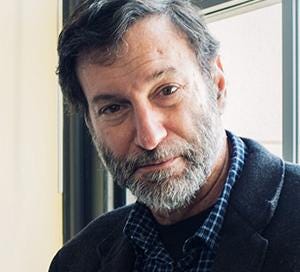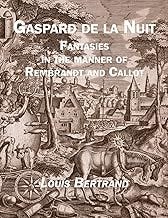"Oil and Water," a Prose Poem and Commentary by Gian Lombardo
Along with Gian's Commentary on a Poem by Paul Éluard
This post is part of a new series which gives excerpts from an anthology I edited called A Cast-Iron Aeroplane That Can Actually Fly: Commentaries from 80 Contemporary American Poets on Their Prose Poetry. A Cast-Iron Aeroplan That Can Actually Fly
In this anthology I asked masters of the prose poem to choose one of their own poems and to write a commentary about the process of writing it. Not only are these prose poems and commentaries interesting in themselves, but they prove that there really is no one way to write a poem, or anything else for that matter.
If you enjoy this post, please consider buying the anthology, where you find prose poems and commentaries from 80 of the best poets writing today.
Few people have done more to champion the prose poem than Gian Lombardo, and yet he’s not as well known as the many poets who shamelessly self-promote and bang the drum of their substantial egos.
Besides being a seminal prose poet, Gian also founded and edited the legendary prose poem journal Key Satch(el), and his press, Quale Press, has published some of the most innovative books of prose poetry over the last thirty years, the most recent being Bob Heman’s Washing the Wings of the Angels. Washing the Wings of the Angels
Gian’s s newest book of prose poems is The Start of Something Beautiful The Start of Something Beautiful, and he recently edited the best and most attractive edition of Bertrand’s
Gaspard de la Nuit: Fantasies in the Manner of Rembrandt and Callot
Below is one of his prose poems with a commentary on it, followed by his thoughts on prose poem by Paul Eluard
38
----------
___ ___
----------
___ ___
___ ___
OIL & WATER
The rope you hold begs the question: How to tie a noose and toss it over a branch? Put it over your head to see how it fits.
But before you can braid that deadly knot, someone grabs the other end and runs. You dig your heels in.
With the rope taut, that someone circles around you. You twirl, describing a smaller orbit to keep from being wrapped in the line. Soon the world’s a queasy blur. Who will let go first?
COMMENTARY
I’ve been using the I Ching, the ancient Chinese book of the divination, to wrestle with problems for most of my adult life. The elaborate ritual of throwing the yarrow sticks to come up with the lines of a hexagram empties mind and heart of everything, so that I’m able to view the problem with fresh eyes, using the text of the resulting hexagram as a guide to seeing the world anew.
I always had the desire to create a book entwined in some way with the I Ching, though I could never decide on its proper form. Then, a few years ago, I realized that a commentary on or the symbolism of each hexagram could generate (as the surrealists said) the flash of an image. I wanted to let that image, or a complex of images, illuminate the barest backbone of a narrative. I wanted to explore the nuances of creating stories by “throwing” images; to investigate what it takes to “see” and how one proceeds from perception to thought and feeling.
“Oil & Water,” the 38th hexagram, is named K’uei–disunion, or mutual alienation. It represents, symbolically, fire (which tends to move upwards) over a marsh (whose waters tend to move downwards). This symbolism yields the interpretation that even where there’s general agreement, there still may be diversity. In terms of its symbolic representation of family relationships, the hexagram can be seen as two sisters who live together but whose wills do not move in the same direction.
For the first thirty-seven hexagrams, the ability to see an image develop from the commentary or symbolism came easily. However, I became blocked by hexagram 38 because it let loose an avalanche of conflicting thoughts and emotions about my family. Instead of a “clearing,” followed by a quasi-revelatory apperception, I became fixed on the apparition of my mother, who was suffering from Alzheimer’s Disease, and her sister, with whom she shared a two-family house. Steadfastly denying my mother’s affliction, my aunt endeavored to care for her, sacrificing time with her own children, grandchildren and great-grandchildren. For twenty years, both sisters lived together after their husbands died, recreating the love—and accompanying conflicts and jealousies—of their childhood. As my mother’s Alzheimer’s progressed her behavior became more paranoid and confused; she became incoherent and withdrawn—a terrible burden for her sister who was exceedingly trusting, lively and sociable.
For weeks I approached K’uei’s text, rereading and rereading, yet nothing came. Finally, afraid the project might grind to a halt, I moved on to the next hexagram. Eventually, the process of working on other hexagrams provided the same “clearing” relief as the ritual of throwing the sticks. Every once in a while, I’d go back to the K’uei, until one time, out of the darkness, came an image from astronomy – that of a double sun (wherein two stars revolve around each other in close proximity). This image captured the essence of these two loving, strong-willed women. Going with that image, I likened the gravity that holds the two stars together (as well as the contra-acting centripetal force keeping them from colliding and fusing) to a rope. And from the rope, a noose. From that point on, the images fell in line in a way that allowed the possibility of a story of two people: one (or the other) decides to “check out” and one (or the other) attempts to keep the one (or the other) alive by pulling on the rope. They end up spinning each other around, locked as much by love as by their conflicting wills until one lets go—a letting go that makes us wonder whether it is a release of love or a refusal to serve.
“Letting go” represents, on another level, the process of relinquishing petty and major thoughts and feelings in order to be able to re-enter life again with eyes open. Considering all these layers of “letting go,” I felt it more appropriate to change the title of the collection from The Briefest Zoo in the Universe to Who Lets Go First.
Commentary on Paul Éluard’s Capital of Pain
I can’t really choose one favorite prose poem because, in many ways, it will vary by moment and mood. But what I can do is go “historic” and pick a book that made me aware of the prose poem. That book was Paul Éluard’s Capital of Pain. My Grossman’s edition, translated by Richard Weisman, is one of my favorite books. (Although now if I dive into it, I’d swim in the original French, but I don’t have any quibble with Weisman’s rendition.)
This book came to me before I had much, or any, time with Baudelaire’s Le Spleen de Paris. Or Bertrand or Rimbaud or Lautréamont or Mallarmé. Capitale de la douleur was a revelation, was foundational, was something I had never seen before. Its language is thick with startling images and a density of metaphor. But was so startling was that it shifted mode from verse poetry to prose poetry with astounding ease. It showed the possibility of a poetic prose that was rich but not cloying, clear and precise but not purple and muddled.
It showed me that there’s more than one way to think, and write, poetry. Each piece manifested its own flexibility. Each piece demonstrated that each poem demanded its own rules of poetics and then could proceed to upend each precept. (Imagine giving a Jesuit some magic mushrooms and a keg of double-bock.) Each poem invented its own world and every world was habitable. From the languid meandering and reflective narrative of “To Be Caught in One’s Own Trap” to the crystalline-hard clarity of the “Nil” sequence of prose poems, the prevailing spirit of the book was chameleon-like.
What was important was the lifting of the restriction from linearity – both in a narrative sense (yes, it is surrealist) but also the freedom from thinking of organizing poems by lines and stanzas (and being overly conscious about how one breathed when reading aloud and silently) to organizing by sentence and paragraph. And what was shown were the myriad differences between what the sentence allowed and what the line allowed: a prose poem – a really dynamite one – is more than taking a poem and removing the line breaks and arranging it as prose. Too many poets lose sight of what that shift of mode truly entails.
But the book was a revelation, a signpost and a guide – introducing me to the underworld of poetry better than any Virgil could. In some ways, for me, it would be appropriate to inscribe “Gather all hope & freedom, ye who enter here” on its flyleaf.
One piece has always stayed with me. On one level for its language, for the explosion of metaphor that sends me both deep into myself and out into the world simultaneously. That makes me pick up the threads of connections, including a key one with Ungaretti’s naufragi. On the other, for showing how seamless the shift remains between verse and prose, and deftly producing unique effects in both modes. With this piece, nothing can become everything:
End of the Circumstances
A disheveled bouquet burns the cocks of waves
And the whole plumage of hell
Radiates in the night and in the sea of the sky
No more horizon, no more cincture,
For the first time, the castaways make gestures that do not support Them. Everything diffuses, nothing can be imagined anymore.
You can find Peter Johnson’s books, along with interviews with him, appearances, and other information at peterjohnsonauthor.com
His most recent book of prose poems is While the Undertaker Sleeps: Collected and New Prose Poems
His most recent book of fiction is Shot: A Novel in Stories
Find out why he is giving away his new book of prose poem/fragments, even though he has a publisher for it, by downloading the PDF from the below link or going to OLD MAN’S homepage. His “Note to the Reader” and “Introduction” at the beginning of the PDF explains it all: Observations from the Edge of the Abyss






So nice to see this. Gian Lombardo is the rare poet whose talent is matched only by his generosity to other poets and his dedication to the prose poem. key satch (el) was one of the great journals for prose poetry and Sky Open Again is a masterpiece I often return to.